AN APPEAL FOR SUPPORT
- We seek your support to meet the expenses relating to the formatting of articles and books, maintaining and running the journal through hosting, correspondences, etc. Please write to the Editor in his e-mail address languageinindiaUSA@gmail.com to find out how you can support this journal. Thank you. Thirumalai, Editor.
BOOKS FOR YOU TO READ AND DOWNLOAD FREE!
- English Language Teaching (ELT) in Saudi Arabia: A Study of Learners' Needs Analysis with Special Reference to Community College, Najran University ... Dr. Mohd. Mahib ur Rahman, Ph.D.
- Provision for Linguistic Diversity and Linguistic Minorities in India ... Vanishree V.M., MAPL and ELT, M.A., PGDHRM.
- Impact of Students' Attitudes on their Achievement in English: A Study in the Yemeni Context ... Hassan Saeed Awadh Ba-Udhan
- A Study of B.ED. Students' Attitude Towards Using Internet in Vellore District, Tamilnadu, India ... T. Pushpanathan, M.A., M.Phil., B.Ed.
- Development of a Hindi to Punjabi Machine Translation System, A Doctoral Dissertation ... Vishal Goyal, Ph.D.
- A Report on the State of Urdu Literacy in India, 2010 ...
Omar Khalidi, Ph.D. - English for Medical Students of Hodeidah University, Yemen - A Pre-sessional Course ...
Arif Ahmed Mohammed Hassan Al-Ahdal, Ph.D. Scholar - Global Perspective of Teaching English Literature in Higher Education in Pakistan ...
Rabiah Rustam, M.S., Ph.D. Candidate - Improving Chemmozhi Learning and Teaching - Descriptive Studies in Classical-Modern Tamil Grammar ...
A. Boologa Rambai, Ph.D. - A Phonetic and Phonological Study of
the Consonants of English and Arabic ...
Abdulghani A. Al-Hattami, Ph.D. Candidate - Some Aspects of Teaching-Learning English as a
Second Language ...
R. Krishnaveni, M.A., M.Sc., M.Phil., Ph.D. Candidate - The Influence of First Language Grammar (L1) on
the English Language (L2) Writing of Tamil School Students: A Case Study from Malaysia ...
Mahendran Maniam, Ph.D. (ESL) - Economics of Crime : A Comparative Analysis of the Socio-Economic Conditions of Convicted Female and Male Criminality In Selected Prisons in Tamil Nadu ...
S. Santhanalakshmi, Ph.D. - Technique as Voyage of Discovery: A Study of the Techniques in Dante's Paradiso ...
Raji Narasimhan, M.A. - A Critical Study of The Wasteland - Poetry as Metaphor ...
K. R. Vijaya, M.A., M.Phil. - Language and Literature: An Exposition - Papers Presented in the Karunya University National Seminar ...
Editor: J. Sundar Singh, Ph.D. - Purism and Language Planning in a Multilingual Context ...
L. Ramamoorthy, Ph.D. - Papers Presented in the All-India Conference on Multimedia Enhanced Language Teaching - MELT 2009 ...
L. Ramamoorthy, Ph.D. and J.R. Nirmala, Ph.D. - A Phonological Study of Variety of English Spoken by Oriya Speakers in Western Orissa - A Doctoral Dissertation ... Arun K. Behera, Ph.D.
- Phonological Analysis of English Phonotactics of Syllable Initial and Final Consonant Clusters by Yemeni Speakers of English ... Abdulghani. M. A. Al-Shuaibi, M.A.
- A Study of Structural Duplication in Tamil and Telugu - A Doctoral Dissertation ... Parimalagantham, Ph.D.
- The Politics of Survival in the Novels of Margaret Atwood ... Pauline Das, Ph.D.
- Nonverbal Communication in Tamil Novels - A Book in Tamil ... M. S. Thirumalai, Ph.D.
- A Study of English Loan Words in Selected Bahasa Melayu Newspaper Articles...
Shamimah Binti Haja Mohideen, M.HSc. (TESL) - The Internal Landscape and the Existential Agony of Women in Anjana Appachana’s Novel LISTENING NOW, A Doctoral Dissertation ...
M. Poonkodi, Ph.D. - Trends and Spatial Patterns of Crime in India - A Case Study of a District in India ...
M. Jayamala,, Ph.D. - The Trading Community in Early Tamil Society Up To 900 AD ...
R. Jeyasurya, M.A., M.Phil., Ph.D. - A Study of Auxiliaries in the Old and the Middle Tamil ...
A.Boologarambai, M.A., Ph.D. - History of Growth and Reforms of British Military Administration in India, 1848-1949 ...
Hemalatha, M.A., M.Phil. - Language of Mass Media: A Study Based on Malayalam Broadcasts - A Doctoral Dissertation ...
K. Parameswaran, Ph.D. - Form and Function of Disorders in Verbal Narratives - A Doctoral Dissertation ...
Kandala Srinivasacharya, Ph.D. - Status Marking in Tamil - A Ph.D. Dissertation ...
P. Perumalsamy, Ph.D. - LANGUAGE AND POWER IN COMMUNICATION ...
Editors: Jennifer M. Bayer, Ph.D., and Pushpa Pai, Ph.D. - Onomatopoeia in Tamil ...
V. Gnanasundaram, Ph.D. - Linguistics and Literature ...
C.Shunmugom, Ph.D., and C. Sivashanmugam, Ph.D., V. Thayalan, Ph.D. and C. Sivakumar, Ph.D. (Editors) - Translation: New Dimensions ...
C.Shunmugom, Ph.D., and C. Sivashanmugam, Ph.D., Editors - Language of Headlines in Kannada Dailies ...
M. N. Leelavathi, Ph.D. - Cooperative Learning Incorporating Computer-Mediated Communication: Participation, Perceptions, and Learning Outcomes in a Deaf Education Classroom ...
Michelle Pandian, M.S. -
The Effects of Age on the Ability to Learn English As a Second Language ...
Mariam Dadabhai, B.A. Hons. - A STUDY OF THE SKILLS OF READING COMPREHENSION IN ENGLISH DEVELOPED BY STUDENTS OF STANDARD IX IN THE SCHOOLS IN TUTICORIN DISTRICT, TAMILNADU ...
A. Joycilin Shermila, Ph.D. - A Socio-Pragmatic Comparative Study of Ostensible Invitations in English and Farsi ...
Mohammad Ali Salmani-Nodoushan, Ph.D. - ADVANCED WRITING - A COURSE TEXTBOOK ...
Parviz Birjandi, Ph.D.
Seyyed Mohammad Alavi, Ph.D.
Mohammad Ali Salmani-Nodoushan, Ph.D. - TEXT FAMILIARITY, READING TASKS, AND ESP TEST PERFORMANCE: A STUDY ON IRANIAN LEP AND NON-LEP UNIVERSITY STUDENTS - A DOCTORAL DISSERTATION ...
Mohammad Ali Salmani-Nodoushan, Ph.D. - A STUDY ON THE LEARNING PROCESS OF ENGLISH
BY HIGHER SECONDARY STUDENTS
WITH SPECIAL REFERENCE TO DHARMAPURI DISTRICT IN TAMILNADU ...
K. Chidambaram, Ph.D. - SPEAKING STRATEGIES TO OVERCOME COMMUNICATION DIFFICULTIES IN THE TARGET LANGUAGE SITUATION - BANGLADESHIS IN NEW ZEALAND ...
Harunur Rashid Khan - THE PROBLEMS IN LEARNING MODAL AUXILIARY VERBS IN ENGLISH AT HIGH SCHOOL LEVEL ...
Chandra Bose, Ph.D. Candidate - THE ROLE OF VISION IN LANGUAGE LEARNING
- in Children with Moderate to Severe Disabilities ...
Martha Low, Ph.D. - SANSKRIT TO ENGLISH TRANSLATOR ...
S. Aparna, M.Sc. - A LINGUISTIC STUDY OF ENGLISH LANGUAGE CURRICULUM AT THE SECONDARY LEVEL IN BANGLADESH - A COMMUNICATIVE APPROACH TO CURRICULUM DEVELOPMENT by
Kamrul Hasan, Ph.D. - COMMUNICATION VIA EYE AND FACE in Indian Contexts by
M. S. Thirumalai, Ph.D. - COMMUNICATION
VIA GESTURE: A STUDY OF INDIAN CONTEXTS by M. S. Thirumalai, Ph.D. - CIEFL Occasional
Papers in Linguistics,
Vol. 1 - Language, Thought
and Disorder - Some Classic Positions by
M. S. Thirumalai, Ph.D. - English in India:
Loyalty and Attitudes
by Annika Hohenthal - Language In Science
by M. S. Thirumalai, Ph.D. - Vocabulary Education
by B. Mallikarjun, Ph.D. - A CONTRASTIVE ANALYSIS OF HINDI
AND MALAYALAM
by V. Geethakumary, Ph.D. - LANGUAGE OF ADVERTISEMENTS
IN TAMIL
by Sandhya Nayak, Ph.D. - An Introduction to TESOL:
Methods of Teaching English
to Speakers of Other Languages
by M. S. Thirumalai, Ph.D. - Transformation of
Natural Language
into Indexing Language:
Kannada - A Case Study
by B. A. Sharada, Ph.D. - How to Learn
Another Language?
by M.S.Thirumalai, Ph.D. - Verbal Communication
with CP Children
by Shyamala Chengappa, Ph.D.
and M.S.Thirumalai, Ph.D. - Bringing Order
to Linguistic Diversity
- Language Planning in
the British Raj by
Ranjit Singh Rangila,
M. S. Thirumalai,
and B. Mallikarjun
Girish Karnad as a Modern Indian Dramatist - A Study ...
B. Reena, M.A., M.Phil.
REFERENCE MATERIAL
- UNIVERSAL DECLARATION OF LINGUISTIC RIGHTS
- Lord Macaulay and
His Minute on
Indian Education - In Defense of
Indian Vernaculars
Against
Lord Macaulay's Minute
By A Contemporary of
Lord Macaulay - Languages of India,
Census of India 1991 - The Constitution of India:
Provisions Relating to
Languages - The Official
Languages Act, 1963
(As Amended 1967) - Mother Tongues of India,
According to
1961 Census of India
BACK ISSUES
- E-mail your articles and book-length reports in Microsoft Word to languageinindiaUSA@gmail.com.
- Contributors from South Asia may e-mail their articles to
B. Mallikarjun,
Central Institute of Indian Languages,
Manasagangotri,
Mysore 570006, India mallikarjun@ciil.stpmy.soft.net. - PLEASE READ THE GUIDELINES GIVEN IN HOME PAGE IMMEDIATELY AFTER THE LIST OF CONTENTS.
- Your articles and book-length reports should be written following the APA, MLA, LSA, or IJDL Stylesheet.
- The Editorial Board has the right to accept, reject, or suggest modifications to the articles submitted for publication, and to make suitable stylistic adjustments. High quality, academic integrity, ethics and morals are expected from the authors and discussants.
Copyright © 2010
M. S. Thirumalai

A Brief Introduction to the Sound System of
Sizang
A Kuki-Chin Language
Bobita Sarangthem Ph. D. CandidateP. Madhubala, Ph. D.

A Sizang Village
Abstract
This paper attempts to present the sound system of Sizang, a Kuki-Chin language. By phonemic status is meant the distinctive function a speech sound or tone performs in keeping words (with their meanings) apart. The contrastive pairs demonstrate the phonemic status of the sounds concerned. Tones, vowels and consonants are dealt within that order to offer relatively extensive and reliable information on the sound system of Sizang. An inventory of the phonemes and allophones of Sizang, specifying their distribution and showing diagrammatically the consonant and vowel phonemes along with their place and manner of articulation are discussed as part of articulatory description.
Introduction
Sizang is a Kuki-Chin language of the Tibeto-Burman family. It is spoken by approximately 10,000 speakers in the Chin state of Myanmar and in north-eastern states of India. Manipur has many ethnic groups having their own ethnic identity. Sizang speaker are found in the southern direction of Manipur state, namely, Moreh, an international border town located on the Indo-Myanmar road south east of Imphal. Moreh is in India, and five kms away from this town is the Tamu town, its Myanmarese counterpart, where Sizang speakers are found in large numbers.
In this paper, an attempt is made to delineate the characteristic features of the sound system of Sizang, based on a lexicon eliciting from our informant Mr. Khampum (45yrs), a native speaker of Sizang, a resident of Tamu Town.
This paper attempts to present an inventory of the phonemes and allophones of Sizang, specifying their distribution and showing diagrammatically the consonant and vowel phonemes along with their place and manner of articulation. The segmental and supra-segmental phonemes are comprehensively given on account of articulatory description.
Bobita Sarangthem, Ph. D. Candidate
Department of Linguistics
Manipur University
Imphal 795001
Manipur
India
loken.lai@gmail.com P. Madhubala, Ph.D.
Department of Linguistics
Manipur University
Imphal 795001
Manipur
India
- Click Here to Access All the Papers of April 2011 Issue
- Click Here for the PRINT VERSION OF ALL THE PAPERS OF APRIL, 2011 ISSUE IN BOOK FORMAT.
- Click Here for Back Issues of Language in India
- Click Here for the HOME PAGE of Language in India
- CONTACT EDITOR languageinindiaUSA@gmail.com

- Click Here to Go to Creative Writing Section
- Send your articles
as an attachment
to your e-mail to
languageinindiaUSA@gmail.com. - Please ensure that your name, academic degrees, institutional affiliation and institutional address, and your e-mail address are all given in the first page of your article. Also include a declaration that your article or work submitted for publication in LANGUAGE IN INDIA is an original work by you and that you have duly acknowledged the work or works of others you either cited or used in writing your articles, etc. Remember that by maintaining academic integrity we not only do the right thing but also help the growth, development and recognition of Indian scholarship.
